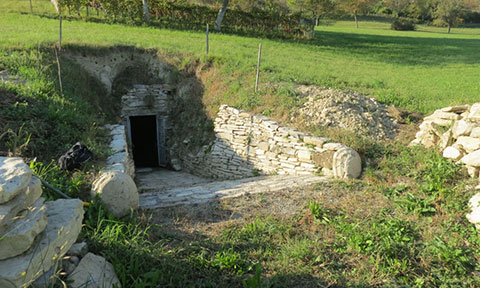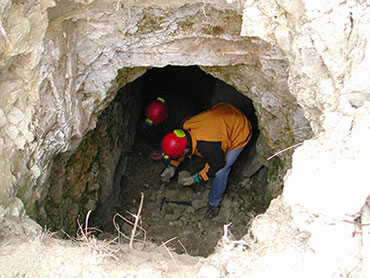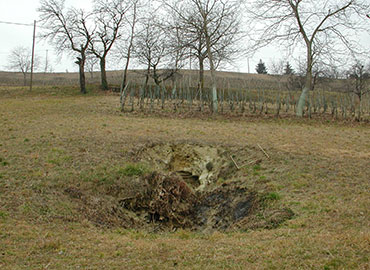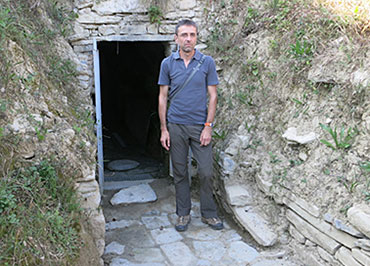|
The cave of Casnea in Briaglia in the italian Province of Cuneo
by Fabrizio Milla
In the 70s a local researcher had claimed that a small artificial cave in the hills of Briaglia, near the town of Mondovi in the province of Cuneo, was an extremely ancient site attributable to prehistoric megalithic peoples.
Between 2012 and 2013, the cave was at the centre of a multidisciplinary project of recovery and investigation to ascertain its origin and nature. Speleologists, archaeologists, archeostronomers and other specialists have worked together to gather information on this cave.
The research showed the astronomical alignment of the cave at the winter solstice, whilst the archaeoastronomical calculations suggested an age of the cavern that expands the research boundaries.
Introduction
Briaglia is a small village, near the town of Mondovì, in the Italian province of Cuneo. The landscape is hilly, mainly covered by woods and pasturages at 546 meters above sea level. To the west it faces the open planes, with a wide view opening onto the Alpine mountain chain further characterised by the unique profile of the Monviso mount, while to the east the slopes descend towards the valley of the Tanaro River. Archelological research in the area has turned up proof of Roman and prehistoric settlements in the area. Professor Ettore Janrigo D'Aquino was an independent researcher fond of history and archaeology. Born in Casale Monferrato, during the 70s he led an in-depth research that spanned the hills of Brigaglia, where he spotted numerous artificial hypogea and many stones that he ascribed to a prehistoric megalithic culture.

|
These also include several menhirs, cromlechs and oddly shaped stones. Though research was conducted with strong endeavour, the academic world has failed to acknowledge the professor's claims due to the lack of what was considered a solid method of study. D'Aquino died in 2005 and both the artefacts and the data collected have almost entirely gone lost.
The research
In 2011 an equip of cultural voluntary associations including cavers, archaeologists, geologists, archaeoastronomers and other specialists, started a complete and articulate project with the purpose of progressing Briaglia’s research and, with the municipal administration, of endorsing the historical and cultural aspects of the village.
The project, named “World of Stone”, consists of:
1) Acquirement of every available document or material
2) Territory investigations
3) Interviews to local residents
4) Census of every marked hypogea
5) Archaeological, geological and other investigations in several locations
6) Presentation of the results and staging of a permanent exhibit
The investigations and research have been focused on the hypogeum known as “Casnea Dolmen”.
The Casnea grotto
Downline of the built-up area (valletta del Rio Frocco), on the east-facing slope, and cultivated with vineyards and grasslands stands an artificial hypogeum marked in the Seventies as “Casnea Dolmen” at only a few meters from the bottom of the valley.

|
The site is considered an ancient place of worship or burial site. Researchers found the entrance obstructed and access was only possible through a hole that opened up in the ground following the collapse of a small portion of the hypogeum vault.
An excavator cleared the entrance and dug out an access corridor to the site.
Cleaning the location revealed a dry stone threshold with vaulted columns preceded by the ruins of 2 stone low walls that decorated the external corridor.
The cavity was excavated in marls and sandstones of the inferior Miocene (Langhian) with a clear clayey component. It is composed by a 1 meter wide and 15 meter long corridor with a barrel vault; near the entrance, along the right wall at ground level, stands a spring water well that measures 7 meters in depth with a diameter of 1 meter. In October 2013, an underwater speleology investigation probed the well finding splays beyond the opening, which drastically increased the well capacity. The walls are abundantly concretionary and the bottom is full of oozy sediment for a non-measurable width. No evidence of anthropic nature was found in what was possible to collect from the bottom.
A square room measuring 3x3 m opens of to the right at the middle of the corridor whilst a similar room is also found at the end corridor to the left. The latter of these walls houses large rectangular stone blocks that sit on ground along the length of two walls. A curious cup mark on the end wall of the corridor, at about 1 meter from the ground, collects the water that drips from the wall and off of a stalactite. Two recesses can be found along the corridor to the left. The whole hypogeum is covered by thick concretions, particularly active in the room at the end of the structure.
The walking ground lies beneath approximately 5 cm of sediment, which has been removed and sifted: several terracotta potsherds were found, along with additional minor findings which were submitted to the Turin Archeological Superintendence for studies and dating.
Various animal bones found were C14 dated, though these traced back only to relatively recent times.

|
The walking ground is made of rock and no pavement could be seen.
The well water seasonally overflows, flooding the hypogeum; therefore, the structure has been it has been reconditioned by building a drainage system, while the vault rebuilt and the collapsed area restored.
The Archaeostronomical investigation
Renovation of the hypogeum and construction of an external access corridor (dromos) has made it possible to confirm an east-west orientation. Observations made reveal that the hypogeum could present some constructive traits of “astronomical” nature linked to the cycle of the sun, particularly to sunrise of the winter solstice. Ruling out plain randomness, it seems that the layout of the hypogeum is linked to a “preventive” horizon observation by the builders, which translates into an application of spherical astronomy. Diurnal spherical astronomy is linked to the daily or seasonal “apparent path” of the sun (apparent as the Earth spins on its own axis and revolves around the sun at the same time). In winter 2012, the location was subject of extensive archaeoastronomical investigation by the expert Piero Barale from Carrù (Cuneo), member of the Italian Astronomical Society. Archaeoastronomy is a branch of archaeology which investigates astronomical knowledge, acquired through specific methods of this discipline, by the pre-historical, classical, late ancient and medieval populations The knowledge gained seeks to unveil how these peoples interpreted celestial phenomena, how they put it to use and what role the celestial sphere held in their cultures. It is a scientific discipline which combines astronomy with both archaeology and anthropology, making it possible in various parts of the world to verify the knowledge ancient peoples and cultures had about celestial phenomena and the way these were assimilated and interpreted to cults and traditions through artefacts, buildings and formations to cults and traditions. The observation of the phenomena linked to the sun, in relation to its positions in the sky, is what allowed ancient communities to schedule all of their activities, both over short terms (days) and long terms (seasons). Nowadays this is possible thanks to technical instruments such as the azimuth compass, the surveyors' cross and the theodolite.
The survey station was set up on 21 December 2012, and the clear day made it possible to record the entire sunrise as to provide documentary evidence of the alignment of the Casnea hypogeum to the rising sun of the winter solstice.

|
The luminous phenomenon in the cavity begins at 8.30 in the morning when the sun rises above the horizon and penetrates the hypogeum with its rays in a tangent orientation. The stone threshold shapes the light into a luminous brush that, as the star rises, moves from the left wall of the corridor towards its centre, until it perfectly overlies its course with an orange light beam. At the peak of the phenomenon, the beam rises up the end wall until it touches the cup mark with an intense light accompanied by a perceivable rise in temperature. Then the light regresses from the grotto, sliding along the right wall, which completely fades approximately 2 hours after it first entered the structure.
Conclusions
Considering the lack of past archaeological evidence able to determine the period in which the Casnea hypogeum was first settled, the archaeoastronomical investigation brought about a slew of data collected in the location. The Institute for Spatial Astrophysics and Planetary Science of Rome states that this kind of alignment might be random in a 1/1000 case (V.F. Polcaro, 2012) and furthermore many archaeological sites, well known and acknowledged (e.g. Newgrange in Ireland) also exist, in which spectacular sunlight phenomena occur, similar to the one in Brigaglia.
Interesting conclusions can be reached if we validate the thesis that the hypogeum was realized with a complicated solar alignment. Furthermore, on the basis of the surveys conducted and given the fact that the obliquity of the ecliptic (the angle comprised between the apparent path of the sun and the equator of the Earth) shifts by a known graduation in a given set of years, which makes it possible to determine the position of the rising sun on the horizon in the past, it is possible to venture a date for the construction. A series of calculations led to the conclusion that the constructive origin dates back to 8,000 B.C.
|
